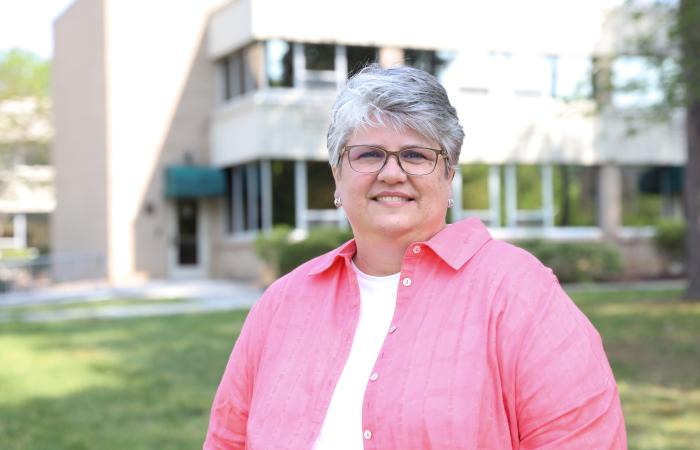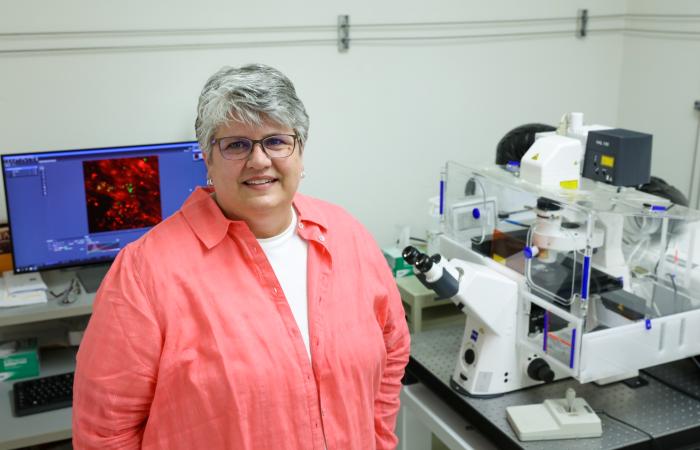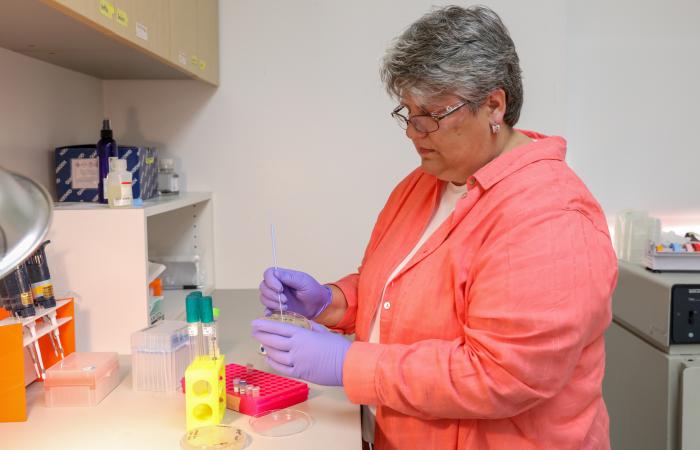-

Jennifer Morrell-Falvey leads the Molecular and Cellular Imaging group at ORNL, advancing new insights in several scientific areas, including the interactions between plants and microbes that influence ecosystem health and carbon cycling. Credit: Carlos Jones/ORNL, U.S. Dept. of Energy
-

Jennifer Morrell-Falvey leads the Molecular and Cellular Imaging group at ORNL, advancing new insights in several scientific areas, including the interactions between plants and microbes that influence ecosystem health and carbon cycling. Credit: Carlos Jones/ORNL, U.S. Dept. of Energy
-

Jennifer Morrell-Falvey leads the Molecular and Cellular Imaging group at ORNL, advancing new insights in several scientific areas, including the interactions between plants and microbes that influence ecosystem health and carbon cycling. Credit: Carlos Jones/ORNL, U.S. Dept. of Energy
-

Jennifer Morrell-Falvey leads the Molecular and Cellular Imaging group at ORNL, advancing new insights in several scientific areas, including the interactions between plants and microbes that influence ecosystem health and carbon cycling. Credit: Carlos Jones/ORNL, U.S. Dept. of Energy
-

Jennifer Morrell-Falvey leads the Molecular and Cellular Imaging group at ORNL, advancing new insights in several scientific areas, including the interactions between plants and microbes that influence ecosystem health and carbon cycling. Credit: Carlos Jones/ORNL, U.S. Dept. of Energy
-

Jennifer Morrell-Falvey leads the Molecular and Cellular Imaging group at ORNL, advancing new insights in several scientific areas, including the interactions between plants and microbes that influence ecosystem health and carbon cycling. Credit: Carlos Jones/ORNL, U.S. Dept. of Energy
Jennifer Morrell-Falvey's interest in visualizing the science behind natural processes was what drew her to the Department of Energy's Oak Ridge National Laboratory in what she expected to be a short stint some 18 years ago. But the extensive capabilities and collegiality at the lab have kept her interested and productive, including the chance to help develop new observational platforms and methods.
Morrell-Falvey's work as leader of the Molecular and Cellular Imaging Group in the Biosciences Division has resulted in new insights in several areas, with a focus on the interactions between plants and microbes that influence ecosystem health and carbon cycling.
ORNL's scientists have been keen to understand the mechanisms behind soil and plant interactions to create better bioenergy crops and explore new ways to enhance natural soil carbon sequestration. Such knowledge could be harnessed to develop plants that use nutrients more efficiently and to design climate-resilient crop management practices.
Morrell-Falvey's work in the Plant-Microbe Interfaces Scientific Focus Area project at ORNL leverages her expertise in molecular genetics, cell biology, fluorescence imaging and biofilms to better understand the beneficial interactions between plants and microbes in the rhizosphere, where plant roots interact with soil.
Mini environment for macro results
One of her recent projects involves working with colleagues like Scott Retterer, John Cahill and others at ORNL to create a "rhizosphere on a chip" - a miniaturized environment in which plant roots can be grown and observed over time interacting with microbes and changing the chemical environment, for instance.
The idea is to study how these living plant-microbe systems function in a platform closer to their native environment. "The rhizosphere is a very complex environment that is difficult to study at the molecular level in its native form, so we use this hybrid approach and recreate an engineered habitat that mimics features of the rhizosphere and allows us to visualize interactions and sample the chemical environment," Morrell-Falvey said.
Using microfluidics, bacterial strains that have been engineered to express fluorescent proteins, and a new liquid extraction mass spectrometry system, the scientists can maintain the plant, in this case the poplar tree, over time and observe the dynamics of how microbes colonize the plant. "What we want to be able to do is look at these responses in a very local way and correlate what's happening to the microbes with what they're responding to in the environment, particularly the chemicals in the habitat, over space and time," she said.
Gentle touch, sharp images with quantum
Morrell-Falvey is also helping develop a quantum microscopy platform that would allow scientists to take a longer look at fragile biological samples at the molecular level without damaging them.
One of the issues with traditional optical microscopy is that the light intensity is high, which can result in damage to biological samples. To minimize those impacts, scientists typically limit how long they image a sample. But by using an entangled pair of photons as the light source, a quantum microscope has much lower light intensity while producing high-resolution images, allowing scientists to image delicate samples more frequently and for longer times, seeing processes they haven't seen before. Morrell-Falvey is working with physicists at ORNL and the University of Michigan to develop the system and compare the results with conventional microscopy techniques.
Morrell-Falvey was hired at ORNL as a staff scientist in 2004, after working as a senior research associate at the University of Tennessee, Knoxville, for a year. She had moved to the area with her husband as he pursued a law degree at UTK. She is also an adjunct faculty member at UT, and she and her husband are proud parents to three kids - two in high school and one in seventh grade.
Prior to her East Tennessee move, Morrell-Falvey was a research professor at the Vanderbilt University School of Medicine in Nashville. She earned her doctorate in genetics at Indiana's Purdue University and a bachelor of arts in biology at Saint Mary's University in Minnesota.
Morrell-Falvey said her father instilled in her an intellectual curiosity about how things work. He was an engineer with the U.S. Bureau of Mines in Minneapolis who loved to read and discuss science and invent things on the side.
"I resisted that influence for a long time, and honestly at one time thought I'd be a teacher. But I was eventually drawn to research, particularly as I took science classes in college," she said. She credits a college professor for the final step into a science career after she was invited into their lab to conduct research.
Seeing complex processes
"It was exciting to be the first person to discover or observe something that no one else had seen before, and that really captured my interest," she said.
Despite the many job titles she has picked up along the way, Morrell-Falvey said she considers herself a cell biologist with a keen interest in microscopy. "Back then, watching how different proteins moved in cells over time and how they influenced cell division - that spatial and temporal organization - that was really, really important for understanding their function. I logged lots of hours at the microscope and very much enjoyed it. It was the 'ah-ha' moment for my career."
She has since traded human cell research for studying plants and microbes and wants to keep exploring ways to observe complex biological processes under native conditions.
The collaborations at ORNL inspire that kind of creativity, Morrell-Falvey said. "Getting together with colleagues, talking about what's possible and thinking creatively is the most fun part of the job."
Morrell-Falvey also enjoys mentoring students and early-career scientists as they explore their interests. She advises young scientists to figure out their passion and be persistent. "If you love it, stick with it. Then you'll enjoy going to work every day."






